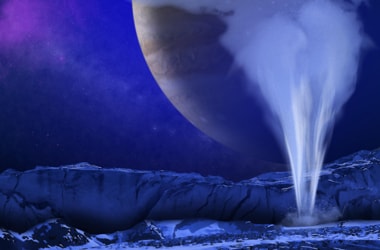Jupiter’s Moon too has water vapour plumes!
Q. Scientists have found icy plumes of water from which moon/s in the solar system?- Published on 29 Sep 16a. Europa
b. Enceladus
c. Both a and b
d. Ganymede
ANSWER: Both a and b

NASA scientists have found water vapour plumes on Europa, a moon of Jupiter. Europa will be the second moon in the solar system known to have water vapour plumes. In 2005, Cassini orbiter from NASA detected jets of water vapour and dust from Enceladus, a Saturnian moon.
- This latest discovery about Europa could give scientists fresh hope that a robotic spacecraft could fly past these potential plumes and learn about their contents without drilling into the icy shell of the moon
- Using UV images taken by Hubble, a space telescope launched in 1990, the plumes were seen on the southern edge of Europa and appear as dark fingers or patches of possible absorption
- This was spotted in 2014 first; finger-like projections were observed while viewing Europa’s limbs as the moon passed ahead of Jupiter
- Plumes are estimated to rise 125 miles or 200 km before, raining material into Europa’s surface
- Europa has a large global ocean that contains twice the water as against Earth’s oceans which are protected by cold and hard ice of unknown thickness
- Plumes provide an opportunity to gather samples originating from under the surface without landing or drilling through the ice.
- Earlier in 2012, a team led by Lorenz Roth of the Southwest Research Institute in San Antonio, detected evidence of water vapour erupting from the frigid south polar region of Europa and reaching more than 100 miles (160 km) into space.
- Although both teams used Hubble's Space Telescope Imaging Spectrograph instrument, each used a totally independent method to arrive at the same conclusion.
- Now scientists will launch the infrared vision of the James Webb Space Telescope to confirm the venting activity on Europa
- Besides, NASA also has a mission to Europa on the cards with the payload confirming the presence of plumes and studying them from close range during multiple fly-bys.
- Hubble is a collaboration between NASA and ESA; the telescope is managed by the Greenbelt, Maryland unit of NASA